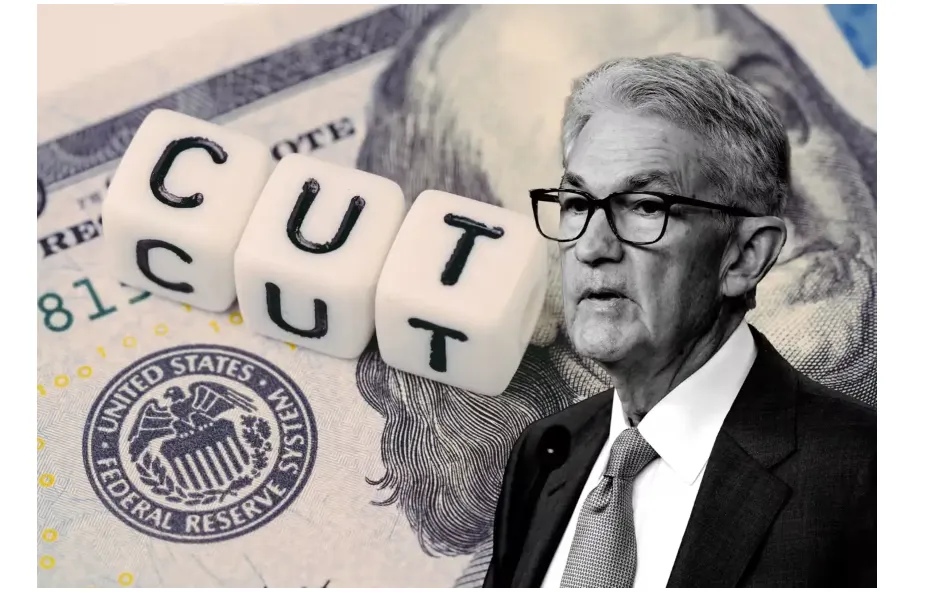The Federal Reserve announced its first interest rate reduction of 2025 on Wednesday, cutting its benchmark rate by a quarter percentage point to a range of 4.00%-4.25% as growing concerns about labor market weakness took precedence over persistent inflation challenges, marking a significant shift in monetary policy direction amid unprecedented political pressure.
The decision, which came after nine months of steady rates, reflects the Federal Open Market Committee’s increasing focus on employment conditions as hiring has stagnated and unemployment has risen to levels not seen since the early days of the COVID-19 pandemic recovery.
One decision can change your entire career. Take that step with our Online courses in ACCA, HESI A2, ATI TEAS 7, HESI EXIT, NCLEX-RN, NCLEX-PN, and Financial Literacy. Join Serrari Ed and start building your brighter future today.
Political Drama Overshadows Monetary Policy Decision
The rate cut announcement was accompanied by considerable political theater, with the Federal Reserve operating under intense scrutiny from the Trump administration. Stephen Miran, President Trump’s newly confirmed appointee to the Fed’s Board of Governors, cast the sole dissenting vote, advocating for a more aggressive half-percentage-point reduction.
Miran, who was confirmed by the Senate just days before the meeting in a 48-47 vote, maintains his role as chair of the White House Council of Economic Advisers while serving on the Fed board—an unprecedented arrangement that has raised concerns about central bank independence.
The new governor’s dissent reflected broader pressure from Trump, who has repeatedly criticized Fed Chair Jerome Powell for moving too slowly on rate cuts, referring to him as “too late Powell” and demanding more aggressive action to stimulate economic growth.
Labor Market Concerns Drive Policy Shift
Fed Chair Jerome Powell emphasized that deteriorating employment conditions motivated the central bank’s decision to begin easing monetary policy. Speaking at a post-meeting press conference, Powell highlighted troubling trends in the job market, including rising minority unemployment and declining opportunities for younger workers.
“The labor market is really cooling off,” Powell stated, noting that recent data shows only 22,000 jobs were added in August, far below economists’ expectations. The unemployment rate has climbed to 4.3%, the highest level since October 2021, while job creation has slowed dramatically compared to 2024 levels.
Powell described the current employment situation as “unusual,” characterized by simultaneous declines in both labor supply and demand. “You see minority unemployment going up. You see younger people… more susceptible to economic cycles… in addition to just overall lower payroll job creation that shows you that at the margin, the labor market is weakening,” he explained.
The Fed chair expressed particular concern that with businesses doing minimal hiring, any increase in layoffs could quickly translate into higher unemployment rates, creating a dangerous cycle that could undermine economic stability.
Inflation Pressures Complicate Policy Decisions
Despite the focus on employment, the Fed continues to grapple with inflation running above its 2% target, with the Personal Consumption Expenditures index projected to reach 3% by year-end. This presents policymakers with the challenging task of supporting employment while avoiding the risk of reigniting price pressures.
Powell acknowledged that Trump administration policies, particularly tariffs, have contributed to goods price increases. However, he indicated that the passthrough effects have been “smaller and slower” than initially anticipated. “To the consumer, the passthrough has been pretty small,” Powell noted, though he warned that companies may eventually pass more costs onto shoppers.
The Fed’s updated economic projections show inflation expectations remaining elevated through 2025, with core PCE inflation forecast at 3.1% for the year before gradually declining toward the 2% target by 2027.
Future Rate Path Signals Cautious Approach
The central bank’s updated “dot plot” projections suggest a measured approach to future rate reductions, with two additional cuts expected before the end of 2025 and only one cut projected for 2026. This outlook disappointed some Wall Street expectations for more aggressive easing.
However, the projections revealed significant disagreement among committee members, with nine of 19 participants indicating they expect only one more cut this year, while ten see two reductions ahead. One outlier projection, likely attributed to Miran, suggested rates could fall below 3% by year-end, indicating support for much more aggressive easing.
Powell characterized the rate cut as a “risk management” decision rather than a response to economic crisis, emphasizing that the Fed remains in a “meeting-by-meeting situation” regarding future policy moves. “There are no risk-free paths now,” he acknowledged. “It’s not incredibly obvious what to do.”
Trump’s Influence Campaign on Federal Reserve
The rate decision came amid an escalating confrontation between Trump and the Federal Reserve over monetary policy independence. The president has mounted what observers describe as an unprecedented pressure campaign, including personal attacks on Powell and attempts to reshape the Fed’s membership.
Trump has simultaneously sought to remove Fed Governor Lisa Cook over unproven mortgage fraud allegations, a move that federal courts have temporarily blocked. Cook, the first Black woman to serve on the Fed board, has denied the allegations and challenged Trump’s authority to fire her.
The controversy surrounding Cook’s dismissal, combined with Miran’s dual role as both Fed governor and White House adviser, has intensified concerns about political interference in monetary policy. Legal experts have warned that allowing such interference could fundamentally undermine the Fed’s ability to make tough decisions based on economic rather than political considerations.
Build the future you deserve. Get started with our top-tier Online courses: ACCA, HESI A2, ATI TEAS 7, HESI EXIT, NCLEX-RN, NCLEX-PN, and Financial Literacy. Let Serrari Ed guide your path to success. Enroll today.
Market Response and Economic Implications
Financial markets showed mixed reactions to the Fed’s decision and forward guidance. Stocks initially rose following the announcement before turning lower as investors analyzed Powell’s comments, with the Dow Jones Industrial Average closing up 260 points while the S&P 500 and Nasdaq finished in negative territory.
The dollar strengthened modestly against major trading partners’ currencies, while Treasury yields showed little change, suggesting markets had largely anticipated the quarter-point reduction. Rate futures markets indicated more than a 90% probability of another cut at the Fed’s next meeting in late October.
Smaller company stocks, as measured by the Russell 2000 index, outperformed broader markets on expectations that lower rates would particularly benefit firms more sensitive to borrowing costs.
Economic Backdrop and Policy Challenges
The Fed’s decision comes as the U.S. economy faces a complex set of challenges that complicate traditional monetary policy approaches. Economic growth has moderated in recent months while inflation remains persistently above target levels, creating an unusual policy environment.
Trump administration policies, including higher tariffs and stricter immigration enforcement, have added uncertainty to the economic outlook. The Fed has carefully evaluated these policy impacts, with officials concluding that while tariffs may boost prices temporarily, they are unlikely to create persistent inflationary pressures.
The central bank’s Summary of Economic Projections shows policymakers expect GDP growth of 1.6% for 2025, slightly higher than previous forecasts, while unemployment is projected to reach 4.5% by year-end before stabilizing around 4.3% in subsequent years.
Historical Context and Central Bank Independence
The current tensions between Trump and the Federal Reserve represent an unprecedented challenge to the central bank’s traditional independence from short-term political pressures. Fed watchers have expressed concern that Trump’s efforts to influence monetary policy through appointments and removal attempts could seriously compromise the institution’s effectiveness.
Powell has consistently emphasized the Fed’s commitment to independence, stating: “It’s deeply in our culture to do our work based on the incoming data and never consider anything else.” However, the presence of Miran—who simultaneously serves the president while voting on interest rates—creates an inherent conflict that challenges this principle.
The Federal Reserve Act of 1913 established that Fed governors can only be removed “for cause,” historically interpreted as malfeasance rather than policy disagreements. Trump’s attempt to redefine this standard has prompted legal challenges that may ultimately require Supreme Court resolution.
Committee Dynamics and Voting Patterns
The 11-1 vote in favor of the quarter-point cut revealed interesting dynamics within the rate-setting committee. Governors Christopher Waller and Michelle Bowman, both Trump appointees who had previously dissented in favor of rate cuts, joined the consensus this time, suggesting they were satisfied with the committee’s decision to begin easing policy.
Miran’s isolated dissent for a larger cut puts him at odds with his fellow Trump appointees and positions him as the most dovish member of the committee. His projection for significantly lower rates by year-end, as reflected in the anonymous dot plot, suggests he favors a much more aggressive easing cycle than his colleagues.
This dynamic creates an unusual situation where Trump’s influence on the Fed is being expressed through competing approaches among his appointees, with Miran advocating for faster rate cuts while Waller and Bowman demonstrate more measured support for gradual policy normalization.
Regional Economic Impact and Sectoral Considerations
The Fed’s decision to begin cutting rates reflects broader concerns about regional economic disparities and sectoral weaknesses that have emerged throughout 2025. Manufacturing activity has shown signs of strain under the impact of trade policies, while service sector growth has moderated from earlier robust levels.
Regional Federal Reserve banks have reported varying conditions across their districts, with some areas experiencing more pronounced job market cooling than others. The Fed’s focus on preventing labor market deterioration aims to address these emerging regional imbalances before they spread more widely.
Small and medium-sized businesses, which are particularly sensitive to credit conditions, are expected to benefit from lower borrowing costs. The Fed’s decision acknowledges that these firms have faced increasing challenges accessing capital as economic uncertainty has increased.
International Considerations and Global Context
The Fed’s rate cut comes as central banks worldwide grapple with similar challenges of balancing growth support with inflation control. The U.S. decision may influence policy discussions at other major central banks, particularly as global economic conditions remain uncertain.
Trump’s trade policies have created additional complications for international monetary policy coordination, as countries adjust to changing trade flows and investment patterns. The Fed has indicated awareness of these global considerations while maintaining focus on domestic economic conditions.
Currency market implications of the rate cut will be closely watched, particularly given the dollar’s role as the global reserve currency and the potential impact on emerging market economies that rely heavily on dollar-denominated financing.
Looking Ahead: Challenges and Uncertainties
The Fed faces a challenging path ahead as it seeks to balance employment and inflation objectives while maintaining institutional independence under political pressure. Powell’s term as Fed chair expires in May 2026, and Trump has indicated he intends to replace him, adding another layer of uncertainty to monetary policy continuity.
The success of the Fed’s policy approach will depend largely on economic data in coming months, particularly employment trends and inflation developments. If labor market conditions continue deteriorating, pressure for more aggressive rate cuts may intensify, potentially forcing the Fed to accelerate its easing cycle.
Conversely, if inflation proves more persistent than expected, the central bank may need to pause or slow its rate reduction plans, potentially creating tension with political expectations for continued easing.
The resolution of legal challenges surrounding Fed governance, particularly the Cook dismissal case, will also influence the central bank’s ability to operate independently and make decisions based solely on economic considerations rather than political pressures.
As financial markets and economic actors adjust to this new environment of heightened political involvement in monetary policy, the Federal Reserve’s ability to maintain credibility and effectiveness while navigating these unprecedented challenges will be closely scrutinized by both domestic and international observers.
Ready to take your career to the next level? Join our Online courses: ACCA, HESI A2, ATI TEAS 7 , HESI EXIT , NCLEX – RN and NCLEX – PN, Financial Literacy!🌟 Dive into a world of opportunities and empower yourself for success. Explore more at Serrari Ed and start your exciting journey today! ✨
Track GDP, Inflation and Central Bank rates for top African markets with Serrari’s comparator tool.
See today’s Treasury bonds and Money market funds movement across financial service providers in Kenya, using Serrari’s comparator tools.
Photo source: Google
By: Montel Kamau
Serrari Financial Analyst
18th September, 2025
Article, Financial and News Disclaimer
The Value of a Financial Advisor
While this article offers valuable insights, it is essential to recognize that personal finance can be highly complex and unique to each individual. A financial advisor provides professional expertise and personalized guidance to help you make well-informed decisions tailored to your specific circumstances and goals.
Beyond offering knowledge, a financial advisor serves as a trusted partner to help you stay disciplined, avoid common pitfalls, and remain focused on your long-term objectives. Their perspective and experience can complement your own efforts, enhancing your financial well-being and ensuring a more confident approach to managing your finances.
Disclaimer: This article is for informational purposes only and does not constitute financial advice. Readers are encouraged to consult a licensed financial advisor to obtain guidance specific to their financial situation.
Article and News Disclaimer
The information provided on www.serrarigroup.com is for general informational purposes only. While we strive to keep the information up to date and accurate, we make no representations or warranties of any kind, express or implied, about the completeness, accuracy, reliability, suitability, or availability with respect to the website or the information, products, services, or related graphics contained on the website for any purpose. Any reliance you place on such information is therefore strictly at your own risk.
www.serrarigroup.com is not responsible for any errors or omissions, or for the results obtained from the use of this information. All information on the website is provided on an as-is basis, with no guarantee of completeness, accuracy, timeliness, or of the results obtained from the use of this information, and without warranty of any kind, express or implied, including but not limited to warranties of performance, merchantability, and fitness for a particular purpose.
In no event will www.serrarigroup.com be liable to you or anyone else for any decision made or action taken in reliance on the information provided on the website or for any consequential, special, or similar damages, even if advised of the possibility of such damages.
The articles, news, and information presented on www.serrarigroup.com reflect the opinions of the respective authors and contributors and do not necessarily represent the views of the website or its management. Any views or opinions expressed are solely those of the individual authors and do not represent the website's views or opinions as a whole.
The content on www.serrarigroup.com may include links to external websites, which are provided for convenience and informational purposes only. We have no control over the nature, content, and availability of those sites. The inclusion of any links does not necessarily imply a recommendation or endorsement of the views expressed within them.
Every effort is made to keep the website up and running smoothly. However, www.serrarigroup.com takes no responsibility for, and will not be liable for, the website being temporarily unavailable due to technical issues beyond our control.
Please note that laws, regulations, and information can change rapidly, and we advise you to conduct further research and seek professional advice when necessary.
By using www.serrarigroup.com, you agree to this disclaimer and its terms. If you do not agree with this disclaimer, please do not use the website.
www.serrarigroup.com, reserves the right to update, modify, or remove any part of this disclaimer without prior notice. It is your responsibility to review this disclaimer periodically for changes.
Serrari Group 2025












